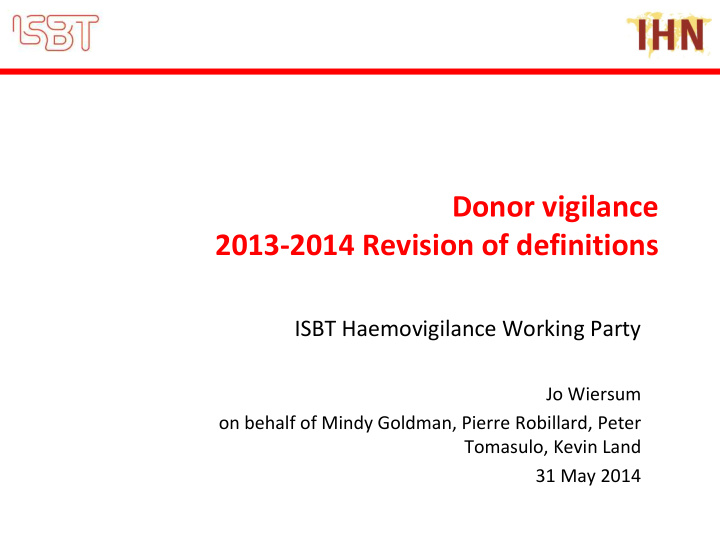



Donor vigilance 2013-2014 Revision of definitions ISBT Haemovigilance Working Party Jo Wiersum on behalf of Mindy Goldman, Pierre Robillard, Peter Tomasulo, Kevin Land 31 May 2014
Steps Amsterdam June 2013 • As discussed in Cancun, incorporate loss of consciousness • Enable alignment to North American definitions • Consider incorporating denominator parameters • Revision group under chairmanship of Mindy Goldman Preliminary draft proposals re VVR discussed, circulated with minutes, reminder Sept. 2013 Comments received from members Comments combined in general draft Feb 2014 Teleconference Circulated to small group of reviewers March 2014 Proposals re painful arm/nerve injury to additional experts, April 2014 Conference call/meeting May 2014
Arm pain Blood outside vessels Haematoma Arterial puncture Delayed bleeding Painful arm (including unconfirmed nerve injury/irritation, and pain from other structures) Arm pain Local Nerve injury/irritation (medically confirmed symptoms cases or with documented nerve type symptoms) Thrombophlebitis Localised infection Cellulitis Other major blood vessel Deep venous thrombosis (DVT) injury Arteriovenous fistula Compartment syndrome • No separate category for tendon injury • Nerve injury / irritation combined (only if medically confirmed, or documented nerve type symptoms) • Cellulitis – new under localised infection
Vasovagal reactions Immediate Generalised Immediate with injury Vasovagal reaction (VVR) symptoms Delayed Delayed with injury SEVERITY Vasovagal reaction (VVR) Wherever possible systems should distinguish between vasovagal reactions with and without loss of consciousness (i.e. mild and moderate VVR) because of the hazards attached to fainting. Mild: VVR without loss of consciousness Moderate: Reaction with loss of consciousness (LOC; fainting)
Allergic reactions Citrate reaction Haemolysis Related to apheresis Air embolism Infiltration Allergy (local) Allergic reaction Generalised allergic reaction Citrate reaction • Signs/symptoms listed • Subdivision offered Mild: Subjective symptoms responding to slowing of return rate and/or oral calcium supplementation Moderate Symptoms necessitated stopping the procedure and/or dyspnea or carpopedal spasm occurred Severe If any standard criteria for severe complications are met, and/or generalised muscle contractions (tetany), shock, severe ypotension, irregular heartbeat, cardiac arrest.
Major cardiovascular event Acute cardiac symptoms (other than myocardial infarction or cardiac arrest) Myocardial infarction Other Major cardiovascular event Cardiac arrest Transient Ischemic Attack Cerebrovascular accident Death from any cause within 24 h after donation Other Subtypes of major cardiovascular event (MCE; to be medically diagnosed) Major cardiovascular events, including death, may occur in the hours both before and after attending the collection centre for blood donation. This can occur without any relation to the donation (for deaths, this is described by the term actuarial deaths). Reporting is encouraged of MCE or death from any cause up to 24 hours after donation, with an assessment of imputability. Only cases with definite, probable or possible imputability should be included in international reporting.
Other F Other complications Other systemic reactions that do not fit into the above, such as chest pain that may have been investigated as angina, but was actually musculoskeletal. G (optional elements under development) Serious operator error Where an operator error occurs which led, or could have led, to serious harm to the donor: e.g. if intravenous saline is used instead of citrate solution (risk of clotting) or if citrate solution is used instead of saline for volume replacement (risk of serious citrate reaction). Serious device incident Where a device, e.g. apheresis disposable, has a defect which led, or could have led to serious harm to the donor. Note that if an error or incident led to a reaction or harm to the donor, the harm will be reported. The reporting categories under F allow for reporting even where no harm occurs, allowing for risks in the collection process to be detected and protective measures to be introduced. Should we mention iron deficiency as a recognised problem which is not well captured at present? In introduction??
New: recommended denominator data • Total donations by type of donation per calendar year – Whole blood • Allogeneic (optional for international comparisons) • Autologous (optional for international comparisons) – Apheresis • RBC + or – plasma (optional for international comparisons) • Platelets + or – plasma (optional for international comparisons) • Plasma only (optional for international comparisons) • All of the above by – Sex of donor – First-time vs repeat donors – Age group of donors • groups to be defined • Total number of donors per calendar year – By type of donations as above – By sex – By first-time vs repeat – By age group
New: basic data about setting • Age criteria for donor eligibility (state for whole blood and apheresis). – Minimum – Maximum • Volume of bags for whole blood collection (may split whole blood denominator into two if very different sizes used, for example 250 ml vs. 450 or 500 ml) • Minimum Estimated Blood Volume criterion (if any) – all donors – subset of donors • Methods of data capture – on site only – on site and when donors call back • Scope of vigilance system – all reactions – moderate and severe reactions – severe reactions only.
Next steps (for discussion) • Comments from today’s discussion and from members • Wider consultation combined with validation: – “ Prepublication draft” posted publicly on working party website – Notification to members and organisations known to us – Validation – May give rise to final adjustments – Circulation and posting of final draft – Approval and publication
Thank you • To all who commented at various stages!
Recommend
More recommend